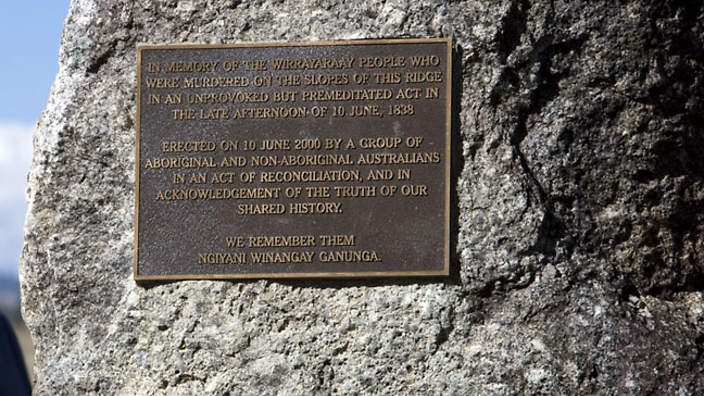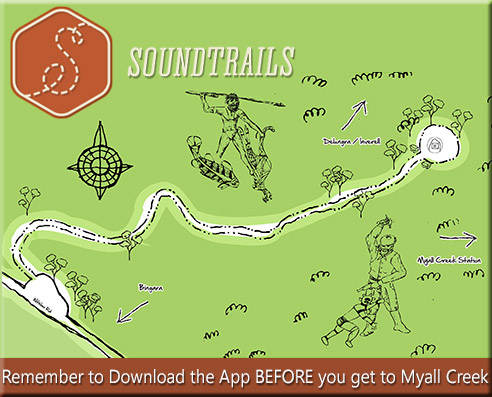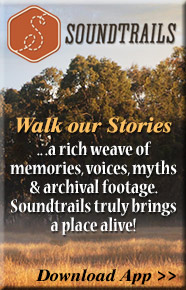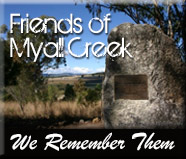Myall Creek Massacre
On June 10, 1838, the infamous Myall Creek Massacre took place at Myall Creek Station where twenty eight Aboriginal men, women and children were massacred and their bodies burned. The ensuing court case marked the first time in Australian history that white men were tried for crimes against Aborigines. Seven men were hanged as a result.
An annual Friends of Myall Creek Memorial Service attracts people from all over the country and is held every June long weekend at the Myall Creek Memorial monument. The project was undertaken by a group of Aboriginal and non-aboriginal people working together in an act of reconciliation. The memorial was erected on June 10, 2000. (162 years to the day!)
The project was awarded the Judith Wright Prize for innovative reconciliation work in 2005.
 The monument opposite stands on a ridge at the end of a 500m memorial path, whose winding shape represents the Rainbow Snake Booragan, and overlooks the site of the massacre, 20km NE of Bingara on the Delungra Road.
The monument opposite stands on a ridge at the end of a 500m memorial path, whose winding shape represents the Rainbow Snake Booragan, and overlooks the site of the massacre, 20km NE of Bingara on the Delungra Road.
7 plaques set in granite boulders along the path give parts of the story in both English and Gamilaraay language, and have illustrations by aboriginal artist Colin Isaacs. Stone benches front each plaque, giving visitors a place to sit and reflect on this shameful part of history.
Myall Creek is now one of Australia’s most important centres of reconciliation and was recognised as such when on the 170th anniversary of the massacre, the site was placed on the National Heritage List. [View news article…] The listing was announced by Heritage Minister Peter Garrett, whilst attending the memorial service.
In November 2010 Minister for Aboriginal Affairs Paul Lynch announced Myall Creek Memorial as part of the NSW State Heritage Register. [View news article…]
Read the Archived Myall Creek Memorial News articles which tell the story from the beginning of the project to present.
TEXT OF THE MYALL CREEK MEMORIAL PLAQUES
Along the walk there are places to stop and reflect on what happened in 1838. Each stopping place has a plaque set on granite rock.
In Gamilaraay language, paraphrased in English
1. Giirr ngurrambaa, walaaybaa nhalay Wirrayaraaygu Gamilaraaygu.
From time immemorial, the Wirrayaraay tribe of the Gamilaraay lived here, caring for the land and harvesting the animals, fish, root crops, grains and fruits in a seasonal cycle. The identity of the Wirrayaraay derived from their spiritual relationship with the land’
2. Yilambu Wandagu dhaay dhimba milambaraay gaanhi.
In the 1830s European squatters began to send their servants into the district to establish cattle and sheep stations, occupying the land and using its grass and water resources to feed their stock.
3. Yilaa Mari Wanda bumalalanhi; balunhi burrulaa Mari gulbirr Wanda.
Conflict soon arose as the Europeans forced the Wirrayaraay off their ancestral lands, drove them away from creeks and waterholes and seized Aboriginal women. The Wirrayaraay retaliated by spearing stock and attacking the stations and their personnel. Revenge killings began.
4. Burrulaa Mari gandjibalu, bawurragu bumaay.
Towards the end of 1837 parties of European stockmen and station hands, encouraged by a punitive expedition of Mounted Police sent from Sydney, embarked on a bloody rampage throughout the region, hunting down and killing any Aboriginal people they could find. Hundreds of Aboriginal people were slain.
5. Wirray bumalalanhi gulbirr Mari Wanda; ganunga maliyaa ginyi.
In May 1838 a band of Wirrayaraay people took refuge from this onslaught on Myall Creek station below, at the invitation of one of the station hands. For the next few weeks they lived in peace around the station huts, and convivial relations were developed between them and the four-man staff.
6. 10 Djun 1838-ya burrulaa Wirrayaraay yinarr, gaay, wayama balunhi; giir bilaarrdhalibaa nhama mari.
On 10 June 1838, a gang of stockmen led by a squatter rode into Myall Creek Station and brutally murdered about twenty-eight unarmed women, children and old men. The younger Wirrayaraay men were away cutting bark on a neighbouring station.
7. Nhama gagil Wanda gaabamandu bumaay. Yilaa Wandagu burrulaa Mari bumaldanhi.
Eleven of the twelve men who carried out the massacre were arrested, tried and acquitted. In a second trial seven of them were found guilty and executed. The squatter involved was never brought to trial. This was the first time that white men had been executed for murdering Aboriginal people. However this did not end the massacres. They continued throughout the continent, often unreported, until the 1920s.
8. Ngiyani winangay ganunga
In memory of the Wirrayaraay people who were murdered on the slopes of this ridge in an unprovoked but premeditated act in the late afternoon of 10 June, 1838.
Erected on 10 June 2000 by a group of Aboriginal and non-Aboriginal Australians in an act of reconciliation, and in acknowledgement of the truth of our shared history.
We remember them.
Courtesy Friends of Myall Creek website which tells the full story and significance of Myall Creek.
 MYALL CREEK SOUNDTRAIL
MYALL CREEK SOUNDTRAIL
Walk our Stories
A Free App is now available that will bring Myall Creek to life. Download the app onto your smart phone or iPad, see yourself on a GPS map and walk freely in and out of sound fields; a rich weave of memories, voices, myths and archival footage. With original compositions, local voices, and world class production, Soundtrails truly brings a place alive!
1. Download the app via the links on www.soundtrails.com.au
2. Download the individual Soundtrail you want to follow
3. Put on your headphones and start walking
If you’re on site you can walk in and out of stories as you follow the map on-screen. GPS will track your location so you trigger stories at specific places. If you’re somewhere else in the world, listen to stories by touching the pin icons on the map.




